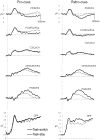Applying an attentional set to perceived and remembered features
- PMID: 19898613
- PMCID: PMC2764142
- DOI: 10.1371/journal.pone.0007613
Applying an attentional set to perceived and remembered features
Abstract
Previous research has examined our ability to attend selectively to particular features of perceptual objects, as well as our ability to switch from attending to one type of feature to another. This is usually done in the context of anticipatory attentional-set control, comparing the neural mechanisms involved as participants prepare to attend to the same stimulus feature as on the previous trial ("task-stay" trials) with those required as participants prepare to attend to a different stimulus feature to that previously attended ("task-switch" trials). We wanted to establish how participants maintain or switch attentional set retrospectively, as they attend to features of objects held in visual short-term memory (VSTM). We found that switching, relative to maintaining attentional set retrospectively, was associated with a performance cost, which can be reduced over time. This control process was mirrored by a large parietal and frontal amplitude difference in the event-related brain potentials (ERPs) and significant differences in global field power (GFP) between switch and stay trials. However, when taking into account the switch/stay GFP differences, thereby controlling for this difference in amplitude, we could not distinguish these trial types topographically. By contrast, we found clear topographic differences between preparing an anticipatory feature-based attentional set versus applying it retrospectively within VSTM. These complementary topographical and amplitude analyses suggested that anticipatory and retrospective set control recruited a qualitatively different configuration of underlying neural generators. In contrast, switch/stay differences were largely quantitative, with them differing primarily in terms of amplitude rather than topography.
Conflict of interest statement
Figures



Similar articles
-
Components of attentional set-switching.Exp Psychol. 2005;52(2):83-98. doi: 10.1027/1618-3169.52.2.83. Exp Psychol. 2005. PMID: 15850156
-
Visual Short-Term Memory Activity in Parietal Lobe Reflects Cognitive Processes beyond Attentional Selection.J Neurosci. 2018 Feb 7;38(6):1511-1519. doi: 10.1523/JNEUROSCI.1716-17.2017. Epub 2018 Jan 8. J Neurosci. 2018. PMID: 29311140 Free PMC article.
-
Electrophysiological correlates of residual switch costs.Cortex. 2010 Oct;46(9):1138-48. doi: 10.1016/j.cortex.2009.07.014. Epub 2009 Aug 5. Cortex. 2010. PMID: 19717147
-
Distinct neurophysiological mechanisms mediate mixing costs and switch costs.J Cogn Neurosci. 2009 Jan;21(1):105-18. doi: 10.1162/jocn.2009.21009. J Cogn Neurosci. 2009. PMID: 18476759
-
Searching for targets within the spatial layout of visual short-term memory.J Neurosci. 2009 Jun 24;29(25):8032-8. doi: 10.1523/JNEUROSCI.0952-09.2009. J Neurosci. 2009. PMID: 19553443 Free PMC article.
Cited by
-
Directing spatial attention to locations within remembered and imagined mental representations.Front Hum Neurosci. 2013 Apr 25;7:154. doi: 10.3389/fnhum.2013.00154. eCollection 2013. Front Hum Neurosci. 2013. PMID: 23630485 Free PMC article.
-
Causes and consequences of limitations in visual working memory.Ann N Y Acad Sci. 2016 Apr;1369(1):40-54. doi: 10.1111/nyas.12992. Epub 2016 Jan 15. Ann N Y Acad Sci. 2016. PMID: 26773268 Free PMC article. Review.
-
Whole-scalp EEG mapping of somatosensory evoked potentials in macaque monkeys.Brain Struct Funct. 2015 Jul;220(4):2121-42. doi: 10.1007/s00429-014-0776-y. Epub 2014 May 4. Brain Struct Funct. 2015. PMID: 24791748 Free PMC article.
-
Visual-spatial attention aids the maintenance of object representations in visual working memory.Mem Cognit. 2013 Jul;41(5):698-715. doi: 10.3758/s13421-013-0296-7. Mem Cognit. 2013. PMID: 23371773 Free PMC article.
-
Beta and Theta Oscillations Differentially Support Free Versus Forced Control over Multiple-Target Search.J Neurosci. 2019 Feb 27;39(9):1733-1743. doi: 10.1523/JNEUROSCI.2547-18.2018. Epub 2019 Jan 7. J Neurosci. 2019. PMID: 30617208 Free PMC article.
References
-
- Sperling G. The information available in brief visual presentations. Psychological Monographs. 1960;74:1–29.
-
- Astle D, Scerif G, Bo-Cheung K, Nobre AC. Spatial selection of features within perceived and remembered objects. Front in Human Neurosci Front Hum Neurosci (2009) 2009;3:6. doi: 10.3389/neuro.09.006.2009. - DOI - PMC - PubMed
-
- Griffin IC, Nobre AC. Orienting attention to locations in internal representations. J Cogn Neurosci. 2003;15(8):1176–1194. - PubMed
-
- Landman R, Spekreijse H, Lamme VA. Large capacity storage of integrated objects before change blindness. Vision Res. 2003;43(2):149–164. - PubMed
-
- Lepsien J, Nobre AC. Cognitive control of attention in the human brain: insights from orienting attention to mental representations. Brain Res. 2006;1105(1):20–31. - PubMed
Publication types
MeSH terms
Grants and funding
LinkOut - more resources
Full Text Sources

